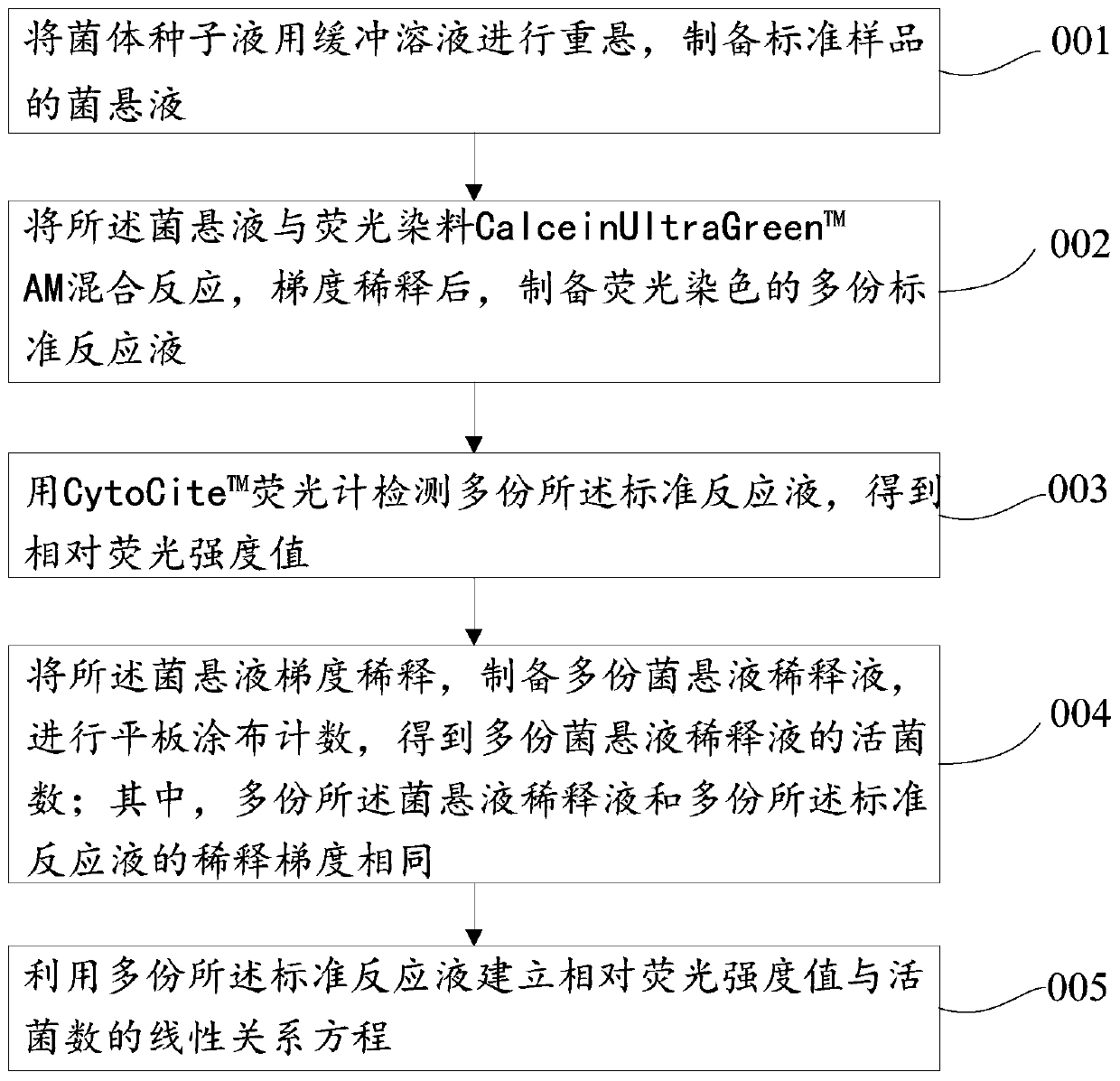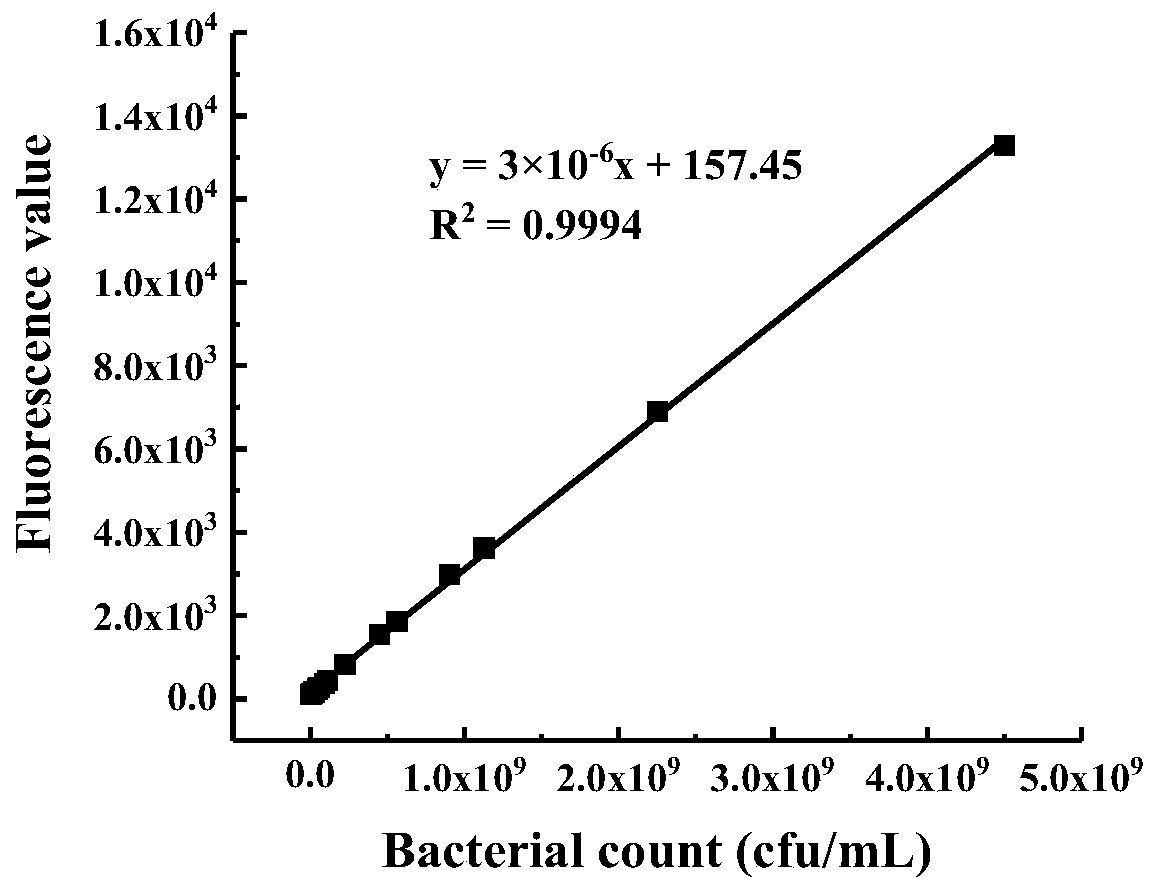Fluorescence detection method of total number of living bacteria
A technology for fluorescence detection and viable count, which is applied in fluorescence/phosphorescence, biochemical equipment and methods, and microbial determination/inspection. The effect of fast detection, simple operation and high sensitivity
- Summary
- Abstract
- Description
- Claims
- Application Information
AI Technical Summary
Problems solved by technology
Method used
Image
Examples
Embodiment 1
[0077] Embodiment 1 (sample to be tested is the cultured bacterium liquid)
[0078] A fluorescent detection method for the total number of living bacteria, comprising the following steps:
[0079] Step S01, centrifuge at 8000r / min at 4°C for 15min, pour off the supernatant, add an equal volume of Tris-HCl (pH=8) solution to resuspend, pipette evenly, and centrifuge at 8000r / min at 4°C After 15 minutes, the supernatant was poured off, and the above-mentioned resuspension steps were repeated three times to obtain the test sample liquid of the liquid bacterial suspension;
[0080] Step S02, establishing the linear relationship equation between the relative fluorescence intensity value and the number of viable bacteria as follows:
[0081] The sample solution to be tested and the fluorescent dye Calcein UltraGreen TM AM mixed reaction, carry out gradient dilution (wherein, described gradient dilution factor is 5 * 10 -2 , 2.5×10 -2 , 2×10 -2 , 1.25×10 -2 、10 -2 , 5×10 -3 ...
Embodiment 2
[0090] Embodiment 2 (the sample to be tested is the cultured bacterium liquid)
[0091] A fluorescent detection method for the total number of living bacteria, comprising the following steps:
[0092] Step S01, centrifuge at 8000r / min at 4°C for 15min, pour off the supernatant, add an equal volume of Tris-HCl (pH=8) solution to resuspend, pipette evenly, and centrifuge at 8000r / min at 4°C After 15 minutes, the supernatant was poured off, and the above-mentioned resuspension steps were repeated three times to obtain the test sample liquid of the liquid bacterial suspension;
[0093] Step S02, establishing the linear relationship equation between the relative fluorescence intensity value and the number of viable bacteria as follows:
[0094] The sample solution to be tested and the fluorescent dye Calcein UltraGreen TM AM mixed reaction, carry out gradient dilution (wherein, described gradient dilution factor is 5 * 10 -2 , 2.5×10 -2 , 2×10 -2 , 1.25×10 -2 、10 -2 , 5×10 ...
Embodiment 3
[0103] Embodiment 3 (sample to be tested is a certain water supply plant water sample)
[0104] A fluorescent detection method for the total number of living bacteria, comprising the following steps:
[0105] Step S01, take 50 mL of water sample, and filter it through a 0.22 μm mixed cellulose filter membrane sterilized by high-pressure steam at 121°C with a vacuum filtration device. Sterilized tweezers grip the edge of the filter membrane to remove the filter membrane, add 50mL of sterile water, and vortex shaker for 30min, so that the bacteria enriched on the filter membrane can be eluted from the filter membrane to obtain the sample solution to be tested ;
[0106] Step S02, establishing the linear relationship equation between the relative fluorescence intensity value and the number of viable bacteria as follows:
[0107] Mix the sample solution to be tested with the fluorescent dye, react at 37°C for 20min, and carry out gradient dilution to the stained reaction solutio...
PUM
 Login to View More
Login to View More Abstract
Description
Claims
Application Information
 Login to View More
Login to View More - R&D
- Intellectual Property
- Life Sciences
- Materials
- Tech Scout
- Unparalleled Data Quality
- Higher Quality Content
- 60% Fewer Hallucinations
Browse by: Latest US Patents, China's latest patents, Technical Efficacy Thesaurus, Application Domain, Technology Topic, Popular Technical Reports.
© 2025 PatSnap. All rights reserved.Legal|Privacy policy|Modern Slavery Act Transparency Statement|Sitemap|About US| Contact US: help@patsnap.com



